Cengiz Öztireli
CHOrD: Generation of Collision-Free, House-Scale, and Organized Digital Twins for 3D Indoor Scenes with Controllable Floor Plans and Optimal Layouts
Mar 15, 2025Abstract:We introduce CHOrD, a novel framework for scalable synthesis of 3D indoor scenes, designed to create house-scale, collision-free, and hierarchically structured indoor digital twins. In contrast to existing methods that directly synthesize the scene layout as a scene graph or object list, CHOrD incorporates a 2D image-based intermediate layout representation, enabling effective prevention of collision artifacts by successfully capturing them as out-of-distribution (OOD) scenarios during generation. Furthermore, unlike existing methods, CHOrD is capable of generating scene layouts that adhere to complex floor plans with multi-modal controls, enabling the creation of coherent, house-wide layouts robust to both geometric and semantic variations in room structures. Additionally, we propose a novel dataset with expanded coverage of household items and room configurations, as well as significantly improved data quality. CHOrD demonstrates state-of-the-art performance on both the 3D-FRONT and our proposed datasets, delivering photorealistic, spatially coherent indoor scene synthesis adaptable to arbitrary floor plan variations.
UMBRAE: Unified Multimodal Decoding of Brain Signals
Apr 10, 2024Abstract:We address prevailing challenges of the brain-powered research, departing from the observation that the literature hardly recover accurate spatial information and require subject-specific models. To address these challenges, we propose UMBRAE, a unified multimodal decoding of brain signals. First, to extract instance-level conceptual and spatial details from neural signals, we introduce an efficient universal brain encoder for multimodal-brain alignment and recover object descriptions at multiple levels of granularity from subsequent multimodal large language model (MLLM). Second, we introduce a cross-subject training strategy mapping subject-specific features to a common feature space. This allows a model to be trained on multiple subjects without extra resources, even yielding superior results compared to subject-specific models. Further, we demonstrate this supports weakly-supervised adaptation to new subjects, with only a fraction of the total training data. Experiments demonstrate that UMBRAE not only achieves superior results in the newly introduced tasks but also outperforms methods in well established tasks. To assess our method, we construct and share with the community a comprehensive brain understanding benchmark BrainHub. Our code and benchmark are available at https://weihaox.github.io/UMBRAE.
Blue noise for diffusion models
Feb 07, 2024



Abstract:Most of the existing diffusion models use Gaussian noise for training and sampling across all time steps, which may not optimally account for the frequency contents reconstructed by the denoising network. Despite the diverse applications of correlated noise in computer graphics, its potential for improving the training process has been underexplored. In this paper, we introduce a novel and general class of diffusion models taking correlated noise within and across images into account. More specifically, we propose a time-varying noise model to incorporate correlated noise into the training process, as well as a method for fast generation of correlated noise mask. Our model is built upon deterministic diffusion models and utilizes blue noise to help improve the generation quality compared to using Gaussian white (random) noise only. Further, our framework allows introducing correlation across images within a single mini-batch to improve gradient flow. We perform both qualitative and quantitative evaluations on a variety of datasets using our method, achieving improvements on different tasks over existing deterministic diffusion models in terms of FID metric.
Zero-Shot Machine Unlearning at Scale via Lipschitz Regularization
Feb 05, 2024



Abstract:To comply with AI and data regulations, the need to forget private or copyrighted information from trained machine learning models is increasingly important. The key challenge in unlearning is forgetting the necessary data in a timely manner, while preserving model performance. In this work, we address the zero-shot unlearning scenario, whereby an unlearning algorithm must be able to remove data given only a trained model and the data to be forgotten. Under such a definition, existing state-of-the-art methods are insufficient. Building on the concepts of Lipschitz continuity, we present a method that induces smoothing of the forget sample's output, with respect to perturbations of that sample. We show this smoothing successfully results in forgetting while preserving general model performance. We perform extensive empirical evaluation of our method over a range of contemporary benchmarks, verifying that our method achieves state-of-the-art performance under the strict constraints of zero-shot unlearning.
DREAM: Visual Decoding from Reversing Human Visual System
Oct 03, 2023Abstract:In this work we present DREAM, an fMRI-to-image method for reconstructing viewed images from brain activities, grounded on fundamental knowledge of the human visual system. We craft reverse pathways that emulate the hierarchical and parallel nature of how humans perceive the visual world. These tailored pathways are specialized to decipher semantics, color, and depth cues from fMRI data, mirroring the forward pathways from visual stimuli to fMRI recordings. To do so, two components mimic the inverse processes within the human visual system: the Reverse Visual Association Cortex (R-VAC) which reverses pathways of this brain region, extracting semantics from fMRI data; the Reverse Parallel PKM (R-PKM) component simultaneously predicting color and depth from fMRI signals. The experiments indicate that our method outperforms the current state-of-the-art models in terms of the consistency of appearance, structure, and semantics. Code will be made publicly available to facilitate further research in this field.
Statistical shape representations for temporal registration of plant components in 3D
Sep 23, 2022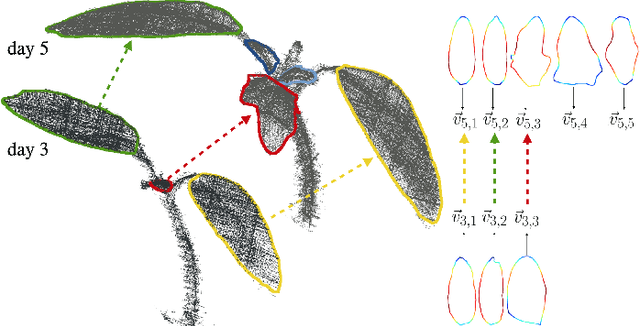
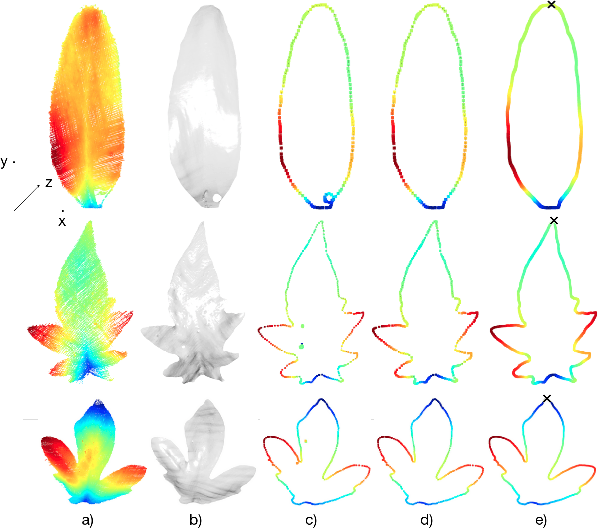
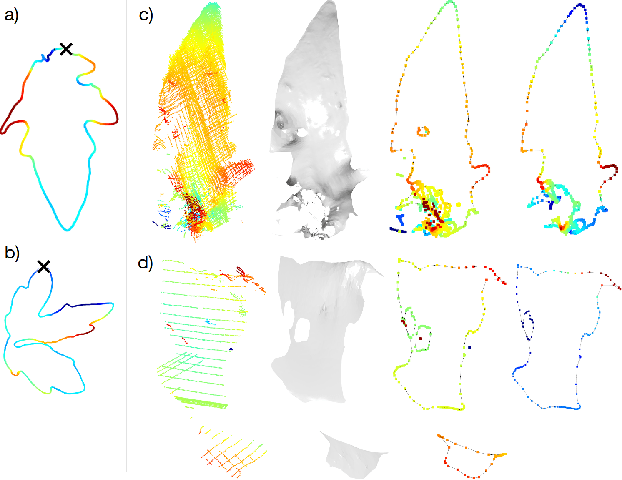
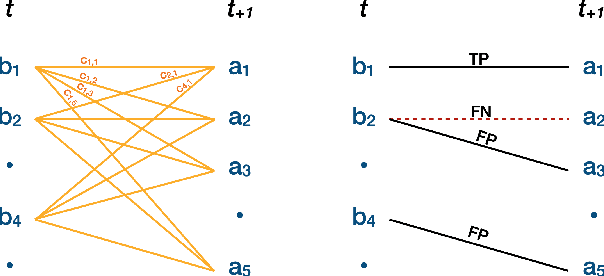
Abstract:Plants are dynamic organisms. Understanding temporal variations in vegetation is an essential problem for all robots in the wild. However, associating repeated 3D scans of plants across time is challenging. A key step in this process is re-identifying and tracking the same individual plant components over time. Previously, this has been achieved by comparing their global spatial or topological location. In this work, we demonstrate how using shape features improves temporal organ matching. We present a landmark-free shape compression algorithm, which allows for the extraction of 3D shape features of leaves, characterises leaf shape and curvature efficiently in few parameters, and makes the association of individual leaves in feature space possible. The approach combines 3D contour extraction and further compression using Principal Component Analysis (PCA) to produce a shape space encoding, which is entirely learned from data and retains information about edge contours and 3D curvature. Our evaluation on temporal scan sequences of tomato plants shows, that incorporating shape features improves temporal leaf-matching. A combination of shape, location, and rotation information proves most informative for recognition of leaves over time and yields a true positive rate of 75%, a 15% improvement on sate-of-the-art methods. This is essential for robotic crop monitoring, which enables whole-of-lifecycle phenotyping.
Path Guiding Using Spatio-Directional Mixture Models
Nov 25, 2021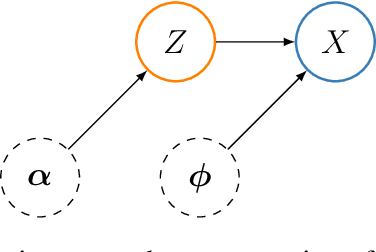
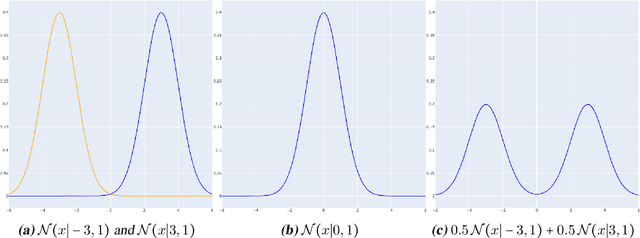

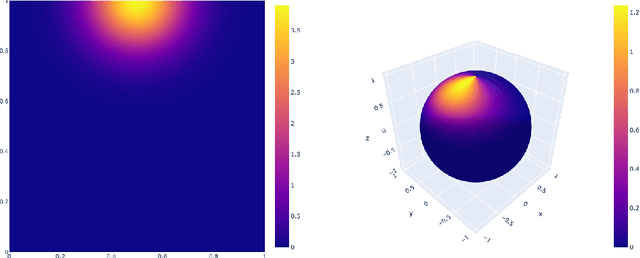
Abstract:We propose a learning-based method for light-path construction in path tracing algorithms, which iteratively optimizes and samples from what we refer to as spatio-directional Gaussian mixture models (SDMMs). In particular, we approximate incident radiance as an online-trained $5$D mixture that is accelerated by a $k$D-tree. Using the same framework, we approximate BSDFs as pre-trained $n$D mixtures, where $n$ is the number of BSDF parameters. Such an approach addresses two major challenges in path-guiding models. First, the $5$D radiance representation naturally captures correlation between the spatial and directional dimensions. Such correlations are present in e.g.\ parallax and caustics. Second, by using a tangent-space parameterization of Gaussians, our spatio-directional mixtures can perform approximate product sampling with arbitrarily oriented BSDFs. Existing models are only able to do this by either foregoing anisotropy of the mixture components or by representing the radiance field in local (normal aligned) coordinates, which both make the radiance field more difficult to learn. An additional benefit of the tangent-space parameterization is that each individual Gaussian is mapped to the solid sphere with low distortion near its center of mass. Our method performs especially well on scenes with small, localized luminaires that induce high spatio-directional correlation in the incident radiance.
Shapley Value as Principled Metric for Structured Network Pruning
Jun 02, 2020



Abstract:Structured pruning is a well-known technique to reduce the storage size and inference cost of neural networks. The usual pruning pipeline consists of ranking the network internal filters and activations with respect to their contributions to the network performance, removing the units with the lowest contribution, and fine-tuning the network to reduce the harm induced by pruning. Recent results showed that random pruning performs on par with other metrics, given enough fine-tuning resources. In this work, we show that this is not true on a low-data regime when fine-tuning is either not possible or not effective. In this case, reducing the harm caused by pruning becomes crucial to retain the performance of the network. First, we analyze the problem of estimating the contribution of hidden units with tools suggested by cooperative game theory and propose Shapley values as a principled ranking metric for this task. We compare with several alternatives proposed in the literature and discuss how Shapley values are theoretically preferable. Finally, we compare all ranking metrics on the challenging scenario of low-data pruning, where we demonstrate how Shapley values outperform other heuristics.
Differentiable Surface Splatting for Point-based Geometry Processing
Jun 14, 2019



Abstract:We propose Differentiable Surface Splatting (DSS), a high-fidelity differentiable renderer for point clouds. Gradients for point locations and normals are carefully designed to handle discontinuities of the rendering function. Regularization terms are introduced to ensure uniform distribution of the points on the underlying surface. We demonstrate applications of DSS to inverse rendering for geometry synthesis and denoising, where large scale topological changes, as well as small scale detail modifications, are accurately and robustly handled without requiring explicit connectivity, outperforming state-of-the-art techniques. The data and code are at https://github.com/yifita/DSS.
Explaining Deep Neural Networks with a Polynomial Time Algorithm for Shapley Values Approximation
Apr 12, 2019

Abstract:The problem of explaining the behavior of deep neural networks has gained a lot of attention over the last years. While several attribution methods have been proposed, most come without strong theoretical foundations. This raises the question of whether the resulting attributions are reliable. On the other hand, the literature on cooperative game theory suggests Shapley values as a unique way of assigning relevance scores such that certain desirable properties are satisfied. Previous works on attribution methods also showed that explanations based on Shapley values better agree with the human intuition. Unfortunately, the exact evaluation of Shapley values is prohibitively expensive, exponential in the number of input features. In this work, by leveraging recent results on uncertainty propagation, we propose a novel, polynomial-time approximation of Shapley values in deep neural networks. We show that our method produces significantly better approximations of Shapley values than existing state-of-the-art attribution methods.
 Add to Chrome
Add to Chrome Add to Firefox
Add to Firefox Add to Edge
Add to Edge